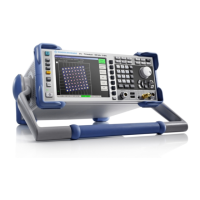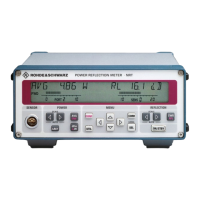R&S FSH Cable Measurements
1309.6275.12 4.69 E-2
When setting the frequency range, users are advised first to set the span and then the center
f
requency. This prevents a message from being output stating that the desired center frequency cannot
be set for the span currently being used for the distance-to-fault measurement.
Press the SPAN key.
The R&S FSH displays the span menu for the DTF
measurement. If automatic setting of the span is
selected, the AUTO SPAN softkey label is highlighted
in green. If the AUTO SPAN softkey is pressed, the
R&S FSH sets the span for the best length resolution.
If the required span is too large for the current center
frequency, the R&S FSH sets the center frequency to
the smallest possible frequency.
Press the MANUAL SPAN key.
Set the required span by using either numeric
entry, the cursor keys or the rotary knob.
Confirm the setting with the ENTER key or by
again pressing the MANUAL SPAN softkey again.
The minimum span that can be set is either 1/10 of the span automatically set by the R&S FSH in the
case of AUTO SPAN or 200 MHz (whichever is smaller). Spans larger than the ones set by the
R&S FSH with AUTO SPAN are not allowed.
Press the FREQ key.
Using either the numeric keys, the cursor keys or
the rotary knob, set the desired frequency.
Confirm the entry with the ENTER key or the
CENTER FREQ softkey.
Calibrating the test setup
The test setup must be calibrated before any measurements are performed. To perform calibration, a
SHORT is required at the output of the 1 m measurement cable. An OPEN can be used instead of a
SHORT. However, if an OPEN is used, greater measurement uncertainties must be expected as an
OPEN is not defined as precisely as a SHORT.
Note: The reference plane must be the output of the 1 m measurement cable; i.e. the
measurement cable may not be dispensed with. If the output of the VSWR bridge is used
as the reference plane, the DTF results are useless.

